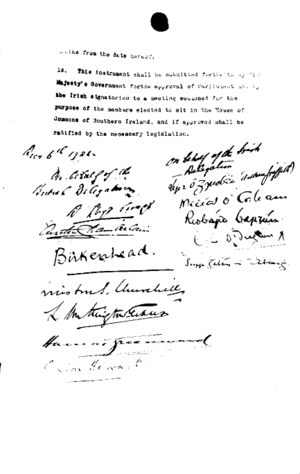Anglo-Irish Treaty Dáil vote facts for kids
The Anglo-Irish Treaty was a very important agreement signed in London on 6 December 1921. It was a peace treaty between representatives of the Irish Republic and the British government. After it was signed, the Irish parliament, called Dáil Éireann, had a big debate about it. This debate lasted from late December 1921 into January 1922.
Finally, on 7 January 1922, the Dáil voted to approve the Treaty. The vote was very close: 64 members voted in favour, and 57 voted against. Four members did not vote. This close vote caused the Sinn Féin political party to split into two groups: those who supported the Treaty and those who were against it. This disagreement sadly led to the Irish Civil War, which lasted from June 1922 to May 1923.
How the Vote Happened
Two elections took place in Ireland in 1921. These elections were part of a plan by the British government to set up new parliaments in Northern Ireland and Southern Ireland. However, the Irish Republic used these elections to decide who would be members of the Second Dáil.
In Southern Ireland, almost all candidates from Sinn Féin won without anyone running against them. This was because of the ongoing War of Independence, which made it difficult for other parties to campaign. Sinn Féin won 124 out of 128 seats. Only Sinn Féin members recognised the Second Dáil as the true parliament of Ireland.
During this time, the Irish Republic's government and the British government, led by David Lloyd George, decided to hold peace talks. On 14 September 1921, the Dáil chose five important people to go to England for these talks. These people were Arthur Griffith, Michael Collins, Robert Barton, Eamonn Duggan, and George Gavan Duffy. They were given full power to negotiate and sign the peace agreement.
These envoys eventually signed the Anglo-Irish Treaty on 6 December. After nearly a month of intense and sometimes angry discussions, the Dáil officially approved the Treaty on 7 January 1922.
The Treaty Vote
The vote on the Anglo-Irish Treaty happened on 7 January 1922. It was a very important moment for Ireland's future.
|
Anglo-Irish Treaty Dáil vote Absolute majority needed: 63 out of 124 |
||
| Vote | Number of Votes | |
|
64 / 124
|
||
| No |
57 / 124
|
|
| Abstentions |
3 / 124
|
|
The Ceann Comhairle, Eoin MacNeill, who was like the speaker of the parliament, did not vote. This is a common rule in parliaments. Four other members, including Michael Collins and Éamon de Valera, had been elected in two different areas. It was decided that they would only cast one vote each.
Out of the 124 members who could vote, 121 cast their vote. Three members who were eligible did not vote:
- Frank Drohan resigned his seat just before the vote. He was personally against the Treaty, but his local Sinn Féin group supported it.
- Laurence Ginnell was not in Ireland; he was in Argentina.
- Thomas Kelly was ill and could not attend.
The final result was 64 votes in favour of the Treaty and 57 votes against it.
What Happened Next
After the Dáil vote, the Treaty also needed to be approved by the British parliament. Irish politicians who supported the Treaty attended the British-created House of Commons of Southern Ireland to approve it there. This time, the vote was unanimous because the members who were against the Treaty refused to attend.
According to the Treaty, a new parliament, often called the Third Dáil, was elected in the 1922 general election on 16 June. Before this election, Michael Collins and Éamon de Valera tried to make a deal between the two sides of Sinn Féin. This deal and the elections were supported by the Second Dáil.
The new parliament was recognised by both Irish nationalists and the British government. It replaced the old parliaments. However, the groups of Irish Republican Army (IRA) members and politicians who were against the Treaty remained strongly opposed to it. Even after the election, their disagreement led to the start of the Irish Civil War.
See Also
- Easter Rising
- Irish Free State
- Members of the 2nd Dáil


